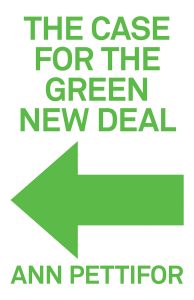The case for the green new deal
As Ann Pettifor explains, the term “new deal” dates back to the Roosevelt-administration’s attempt to use the full force of the US government to combat unemployment and revive the economy during the crisis of the 1930s. A central element in the endeavour was to invest massively in a number of socially useful initiatives in e.g., energy, infrastructure, natural parks, reforestation etc. Hence the approach combined economic policy goals with broader social and political objectives. A decade ago Thomas Friedman of the New York Times coined the term “green new deal” for a policy approach that simultaneously dealt with the economic crisis at the time and the climate crisis. This approach was subsequently taken up by several others, including Pettifor. More recently, and perhaps more well known, the concept has been used by the US politician Alexandria Ocasio-Cortez for “a plan to solve three critical problems at once: the treat climate change poses to America’s security, poverty and inequality and the racial wealth gap” (cited after Pettifor, p.5).
US government to combat unemployment and revive the economy during the crisis of the 1930s. A central element in the endeavour was to invest massively in a number of socially useful initiatives in e.g., energy, infrastructure, natural parks, reforestation etc. Hence the approach combined economic policy goals with broader social and political objectives. A decade ago Thomas Friedman of the New York Times coined the term “green new deal” for a policy approach that simultaneously dealt with the economic crisis at the time and the climate crisis. This approach was subsequently taken up by several others, including Pettifor. More recently, and perhaps more well known, the concept has been used by the US politician Alexandria Ocasio-Cortez for “a plan to solve three critical problems at once: the treat climate change poses to America’s security, poverty and inequality and the racial wealth gap” (cited after Pettifor, p.5).
The starting point for Pettifor’s analysis is the widely held view that the current economic trajectory of the global economy is not sustainable, and needs to be substituted with a system that operates within planetary boundaries, a “steady state economy” as she calls it. The driving force behind the present, unsustainable trajectory, it is argued, is primarily cheap credit supplied by a global financial industry operating without proper democratic control. A large part of the book is used to provide the historical backgrounds for the current state of affairs. In order to change course in a more sustainable direction, she argues, the nation state, and democratically elected politicians, need to retake control of financial markets and cross-border capital flows, and use this position to provide finance – through bond issue for example – for the massive structural changes that the transition require. She is more hesitant when it comes to taxing carbon (or the EU’s system of tradable permits) because these – at least in relative terms – implies a higher burden for the poor than the rich (who, she points out, emits much more), and may lead to reactions (the “gilets jaune” in France for example) that delay rather than speed up necessary changes. Hence, carbon taxes, in her view, should if these are deemed necessary primarily be levied on the rich.
This an interesting and highly readable discussion of policies for sustainability transitions in the developed part of the world. However, the analysis is not very concrete when it comes to how the new, sustainable economy may look like, although it is clear that e.g., renewable energy and public transport are seen important features. Moreover, innovation is hardly mentioned. One wonders if the “steady state economy” is a totally stationary society and, in case, why that should be a goal?
Ann Pettifor: The case for the green new deal, Verso, 2019, 185 p.